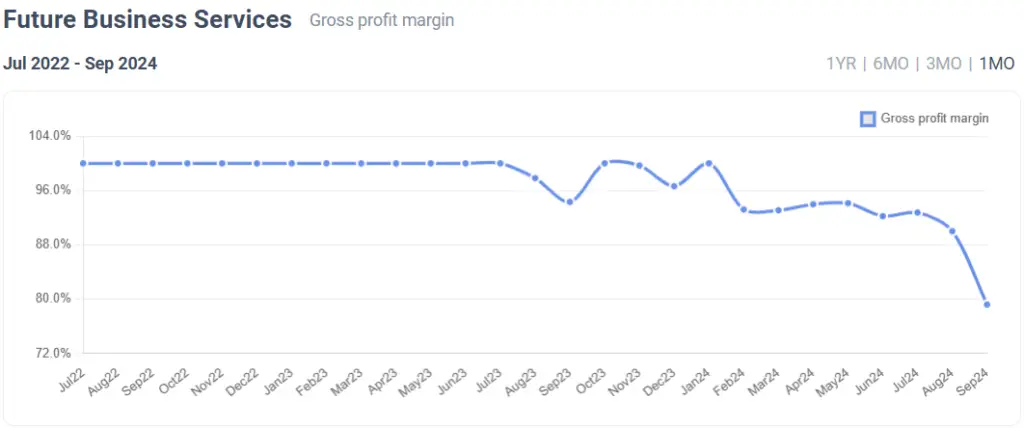Why Tracking Your Gross Profit Margin is Essential for SMBs: A Key Financial Metric for Small Business Management

Gross Profit Margin: An Essential Metric For SMBs
Managing a small or medium-sized business (SMB) successfully requires more than just generating sales—it’s about ensuring those sales turn into sustainable profits. One of the most critical financial metrics for small business owners to understand and regularly track is their gross profit margin (GPM). This key metric offers insights into how efficiently your business is managing its production costs relative to its revenue. Despite its importance, many small business owners overlook or misunderstand the value of tracking their GPM, leading to poor financial decisions that could hurt their long-term success.
In this blog post, we’ll explore why monitoring your gross profit margin is essential for SMBs, how it connects to other aspects of small business management, and why it’s important to distinguish between profit margins and cash flow.
What is Gross Profit Margin?
The gross profit margin is a key indicator of profitability and operational efficiency. It measures the percentage of revenue that remains after deducting the cost of goods sold (COGS)—which includes expenses like raw materials, labor, and other direct production costs.
The formula for calculating GPM is:
GPM=Revenue−COGSRevenue×100text{GPM} = frac{text{Revenue} – text{COGS}}{text{Revenue}} times 100GPM=RevenueRevenue−COGS×100
For example, if your SMB generates $100,000 in revenue and your COGS is $60,000, your gross profit margin would be:
100,000−60,000100,000×100=40%frac{100,000 – 60,000}{100,000} times 100 = 40%100,000100,000−60,000×100=40%
This means that 40% of your revenue remains after covering production costs. The higher the gross profit margin, the more efficient your business is in turning revenue into profit.

Why Tracking Gross Profit Margin Matters for SMBs
Understanding and regularly tracking your gross profit margin is crucial for maintaining a financially healthy SMB. Here are several reasons why GPM is an essential financial metric for small business owners:
1. Gauging Business Efficiency
A strong gross profit margin indicates that your business is effectively managing production costs and retaining a healthy portion of revenue. Tracking GPM helps small business owners assess their operational efficiency. If your GPM begins to decline, it can signal that production costs are rising or that your processes are becoming less efficient.
For instance, if your supplier costs increase or you experience higher labor expenses, your GPM will shrink. By monitoring your GPM closely, you can identify cost issues and address them before they negatively impact your profitability.
2. Pricing Strategy for SMBs
Gross profit margin directly affects your pricing strategy, which is a critical part of small business management. Many SMB owners price their products or services based on market competition without factoring in their own production costs. If your prices are too low relative to your costs, your GPM will suffer, reducing profitability.
On the other hand, pricing too high may deter customers and reduce sales. Regularly reviewing your GPM allows you to strike the right balance between competitive pricing and maintaining profitability. Adjusting your prices based on your GPM can also ensure that your business remains sustainable.
3. SMB Management: Planning for Business Growth
For any small business management strategy to succeed, growth must be carefully planned. A healthy gross profit margin ensures that your SMB can absorb the costs associated with growth, such as hiring new employees, expanding locations, or investing in new equipment. If your GPM is strong, you have the financial buffer to scale up operations without jeopardizing your bottom line.
Additionally, lenders and investors often scrutinize your GPM as part of their assessment of your business’s financial health. A consistent and high GPM indicates that your business is financially viable, which can improve your chances of securing loans or investment to fuel further growth.
4. Comparing Against Industry Benchmarks
Every small business operates within an industry that has its own set of standards for profitability. By comparing your gross profit margin against industry benchmarks, you can see how your business stacks up. If your GPM is lower than industry averages, it may signal inefficiencies or areas that need improvement. Conversely, a higher-than-average GPM suggests that your business is operating more efficiently than competitors.
This benchmarking helps you stay competitive and find areas for optimization in your small business management practices.
The Relationship Between Gross Profit Margin and Cash Flow
While gross profit margin is an essential indicator of profitability, it’s not the same as cash flow—and it’s critical for SMB owners to understand the difference. Many business owners mistakenly believe that a high GPM automatically results in strong cash flow, but that’s not always the case.
Gross Profit Margin Reflects Profitability
Gross profit margin tells you how much of your revenue is left after covering production costs. This remaining amount, known as gross profit, is used to cover your operating expenses (rent, marketing, salaries, etc.) and ideally, leave you with net profit.
However, your gross profit margin doesn’t account for other financial factors such as overhead costs, debt repayments, and taxes, which all impact your overall financial health. While a healthy GPM indicates your business is pricing its products and services correctly, it doesn’t mean your cash flow is equally healthy.
Cash Flow is Key to Business Survival
Cash flow refers to the actual money flowing into and out of your business during a specific period. Positive cash flow occurs when you have more money coming in than going out, while negative cash flow indicates that your expenses are exceeding your income. A business can have a strong gross profit margin but still struggle with cash flow issues if, for example, customers delay payments or inventory is overstocked.
Unlike gross profit margin, cash flow deals with the timing of income and expenses. Even if your profit margin is strong, a delay in receiving customer payments or making supplier payments can lead to cash shortages, which can hurt your ability to pay bills or cover operating costs.
Why Cash Flow and Profit Margins Don’t Always Align
Here are some reasons why a business can have a high gross profit margin but still face cash flow challenges:
- Customer Payment Delays: If your customers take a long time to pay invoices, your cash levels might suffer, even though your GPM looks healthy on paper. This is a common issue for SMBs offering extended payment terms.
- Inventory Management: Overstocking inventory ties up cash that could be used elsewhere in the business. Even with a strong GPM, holding too much inventory can hurt your liquidity and overall financial flexibility.
- Debt Payments: Debt repayments reduce your available cash. Even if your gross profit margin is healthy, large loan repayments can strain your cash flow, making it difficult to meet day-to-day operational expenses.
Balancing Profit Margins and Cash Flow for Small Business Management
To ensure long-term success, SMBs need to strike a balance between maintaining a healthy gross profit margin and managing cash flow effectively. Here are a few tips for achieving this balance:
- Shorten Payment Terms: Encourage customers to pay faster by offering early payment discounts or enforcing stricter payment terms.
- Monitor Inventory Levels: Avoid tying up cash in excessive inventory. Improve inventory turnover to free up working capital.
- Track Both GPM and Cash Flow: Use financial tools like Jazoodle to monitor your gross profit margin and cash flow in real-time. This ensures that you stay on top of these critical metrics and can make informed decisions.
Conclusion
Tracking your gross profit margin is one of the most essential financial metrics for small business owners. It provides insights into your business’s efficiency, informs pricing decisions, and supports growth planning. However, it’s important to remember that while a healthy GPM is crucial, it doesn’t guarantee strong cash flow. Cash flow management is equally important for ensuring the day-to-day survival of your business.
By balancing both gross profit margin and cash flow, SMB owners can maintain financial health, plan for sustainable growth, and ensure long-term business success.
Using tools like Jazoodle’s app to monitor these financial metrics can help small and medium-sized businesses keep their small business management on track and drive profitability.


